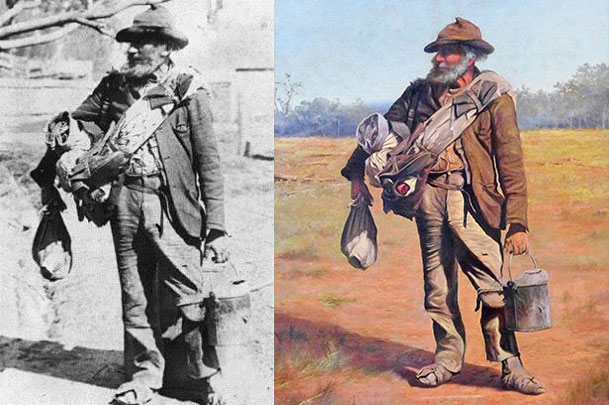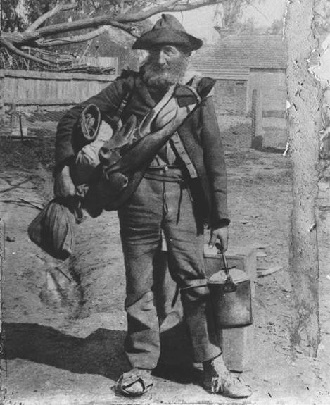
Who was the Bidgee Whaler?
The legend
"Whalers" were homeless men, often called "swagmen", commonly seen from the 1890s financial depression onwards. They wandered the countryside, camped rough and occasionally chopped firewood on stations to put food in their tucker bags. Swagmen became iconic figures in Australian folklore, tramping along dusty tracks with a rolled-up blanket or "swag" on their back and a billycan in their hand. They were immortalised in Banjo Paterson's "Waltzing Matilda", celebrated in Henry Lawson's poem The tent poles are rotting and depicted in Fred McCubbin's painting Down on his luck.
There were many "Bidgee Whalers" in Wagga's past. They trudged along the banks of the Murrumbidgee River and survived by fishing and begging food or occasionally working at stations (farms) up and down the river. One particular Bidgee Whaler stands out in Wagga's History. In the 1980s Sylvia Walsh wrote about him as follows ..."
... older identities, Wagga born folk, including one of this writer's relatives born in the late 1880s remember him as Joe the Whaler. Although various stories are told of who and what the "Whaler" was, most agreed on one point – he was of genteel English birth and had been well educated. Through his indulgence in drinking or gambling or both, he had disgraced his family and was banished to Australia; a remittance man who quickly squandered his remittance money when it arrived from the 'Old Country' every three months or so.
The story is that the Murrumbidgee Whaler's name was Joe Banks, sometimes called Mad Joe. In his earlier years he was, it seems, interesting to talk to but as time went by and after more frequent drinking, he became sullen, morose and uncommunicative. One of his eccentricities was the wearing of two or more hats at the one time.
When his remittance money was running out he took to the road, cutting firewood for a refill of his tucker bag. His favourite track was the area between Wagga Wagga and Gabbagombalin. Sometimes he camped in the hollow of a large gum tree on the North Wagga river flats.
Two of his favourite haunts were the Black Swan Hotel at North Wagga and the Caledonian Inn at Cartwright's Hill near the intersection of the Junee, Coolamon and Bomen roads.
On one occasion Joe was sitting on the verandah of the Caledonian when the local brewer, W Eaton, called on his rounds as was the custom in those days, canvassing for trade. It was usual on such visits for the brewer to shout for those in the bar at the time.
Walking to the door, Bill Eaton asked Joe if he would like a drink. Joe mumbled in assent and the publican poured him a pint. After the third invitation and the third pouring of a pint Joe took the mug and without a word walked onto the verandah, poured the contents into his billy and disappeared down the road.
Sometimes the local police took Joe into custody. They cleaned him up, trimmed his hair and beard before sending him on his way again.
The colored painting by Charles Astley, dated 1908, which hangs in the Riverine Club is said to be a copy of the photograph which [later] appeared in the "Back to Wagga" souvenir book published in October 1927. The artist has made the painting attractive by using color and introducing an interesting background.
The Murrumbidgee Whaler despite his habits and his past or maybe because of them, has become a legend.
The painting
A painting of the Bidgee Whaler hangs in the Riverine Club. It was painted by Charles Astley in 1908 from a photo. The photo, later published in the Back to Wagga book in 1927, shows a different background to that chosen by Astley.

At left is the photo on which Astley based his 1908 painting of Bidgee Whaler, shown at right.

Another photo of the Bidgee Whaler
There is also a front-facing photo taken in the same place that appears to be of the same whaler.
There was another Astley painting of Bidgee Whaler, stolen from the house of Mrs Muriel Thompson after she died in October 1983. Sylvia Walsh wrote, under the pen name of Bidgee Whaler, in the Daily Advertiser on 17 November 1983 ...
... a day or two after her death some person or persons broke into her home in North Wagga and stole a framed, coloured painting of the "Bidgee Whaler" painted and signed by Charles Astley the artist who painted the "Whaler" which hangs in the Riverine Club. The painting had been given to Mr. Pulver by the artist.
It was treasured by the family. It graced a wall of the home probably during all of this century [1900s]. Mr Claude Pulver, now in his mid 70s, remembers it being there all his life time.
The composition of the painting differs from the other one by Astley. It depicts the Bidgee Whaler sitting in front of a hollowed-out tree which had a rough lean-to attached. The Whaler was known to camp in the hollow of a tree on the North Wagga flats.
The theft of the painting shocked and saddened the remaining members of the Pulver family. They would dearly like to have it returned.